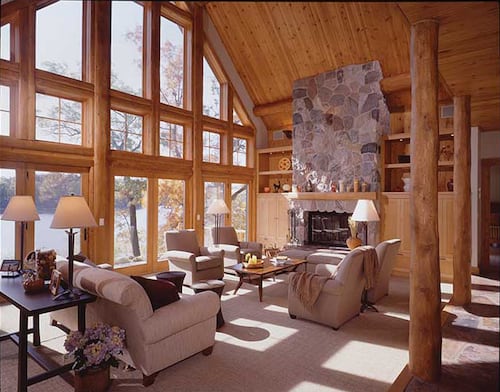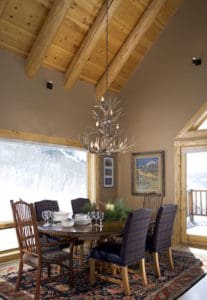Log Siding Adds Texture and Personality to Inside Spaces
 Log siding can transform any space into a warm, cozy log cabin-feel at a fraction of the price of a traditional stacked log home. There are many ways to use log siding on interior walls to create the design of your client’s dreams. Here are some tips for selecting the right log sizes, textures, and colors for your project.
Log siding can transform any space into a warm, cozy log cabin-feel at a fraction of the price of a traditional stacked log home. There are many ways to use log siding on interior walls to create the design of your client’s dreams. Here are some tips for selecting the right log sizes, textures, and colors for your project.
Sizes
When selecting the sizes and textures of log siding, be sure to choose products that will complement the home design. The most popular sizes of log siding are half log and quarter log. Half log siding is 3” thick and has a more rounded face than quarter log. This size is best for achieving a true log home look indoors and will add lots of natural architectural appeal to any room. Quarter log siding is 2” thick and has a slightly rounded face. This option offers design versatility and allows homeowners to more easily hang artwork to decorate their log or timber frame home.
Textures
Choosing the right texture for your interior log siding project can add exciting aesthetic appeal to the design. For example, if your client wants a classic log home look, you may opt for hand hewn siding or beveled siding. If the desire is for a more modern design, you may choose adzed log siding. There are a variety of textures to choose from to make the design more dynamic. Check out your options.
Colors
Whether you opt for the natural beauty of a stained wood or want to incorporate a pop of color, log siding is very versatile and can hold many types of finishes. Work with the homeowner to select a color palette that complements the home design and their lifestyle. Consider using a few different colors to add visual appeal. You can also use colors/stains to highlight structural details. Bonus: Using an interior finish will also help protect the logs and make them easier for homeowners to clean down the road.
 Non-log Walls and Ceilings
Non-log Walls and Ceilings
There may be a few walls that you don’t plan to add log siding to. To ensure a homogenous design, consider adding some wood features to non-log walls. For instance, apply log paneling and coordinate with trim and paint. Trim along windows, doors and baseboards can add beautiful wood accents to non-log walls and will help the space look polished and complete.
Also keep in mind that log siding can be applied to ceilings just as easily as it is to walls. A wood ceiling can create an attention-grabbing feature and draw the eye to the ceiling height.
Whether you’re using log siding throughout a home or just want to transform one room, Heartwood Mills can provide the materials and guidance you need for your project. Contact our log siding experts to learn more about how to best use log siding on interior walls.
